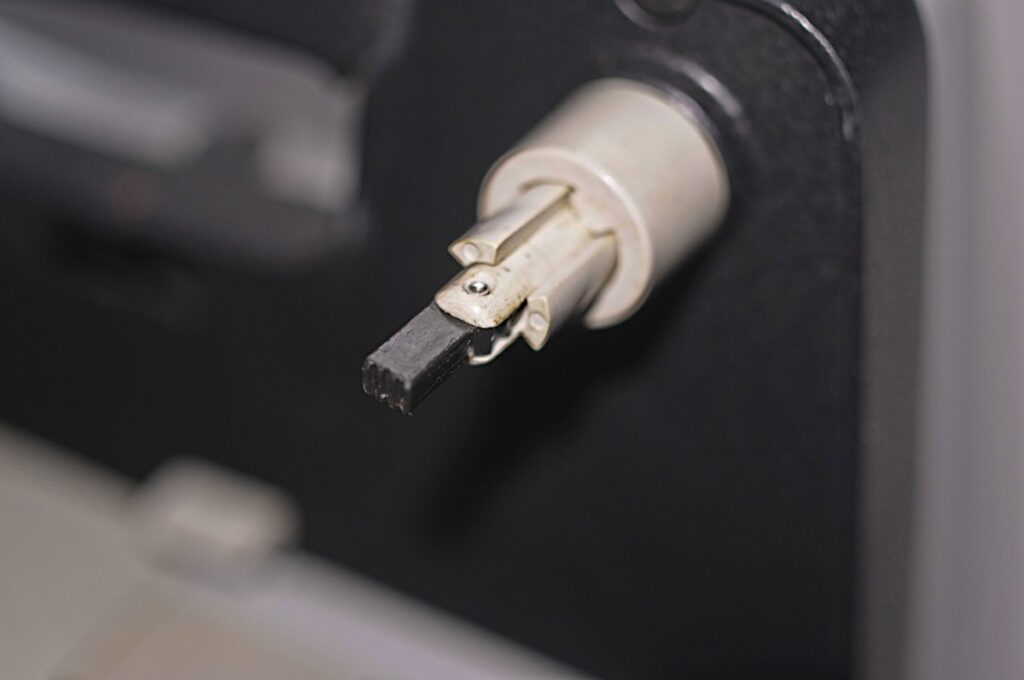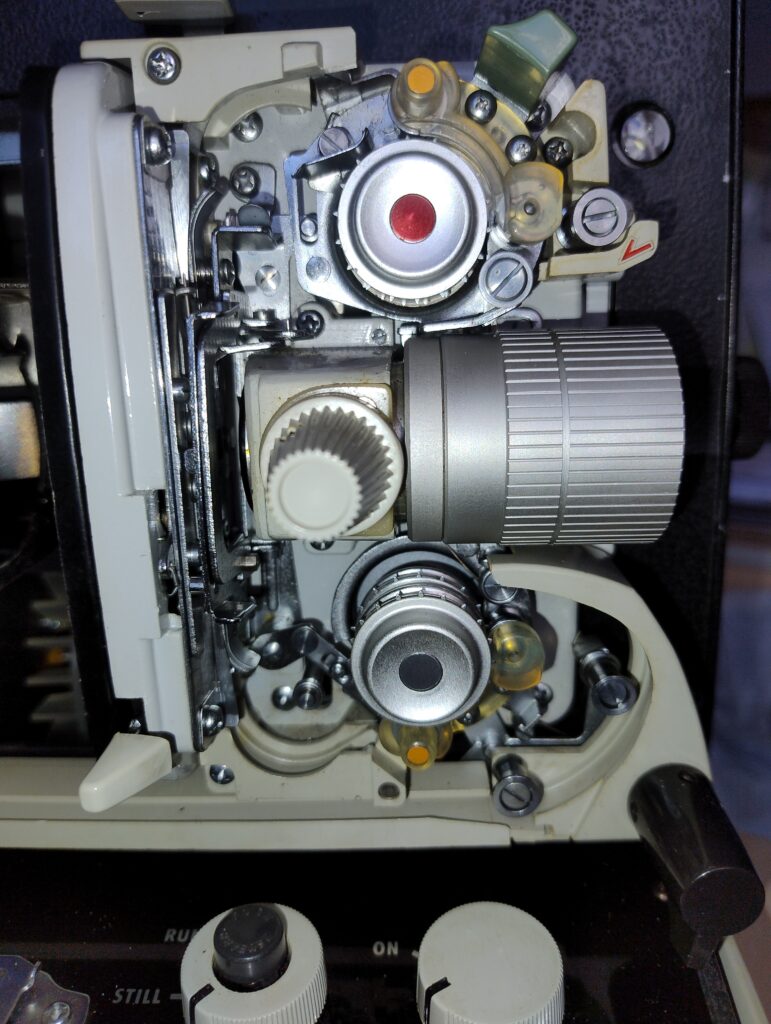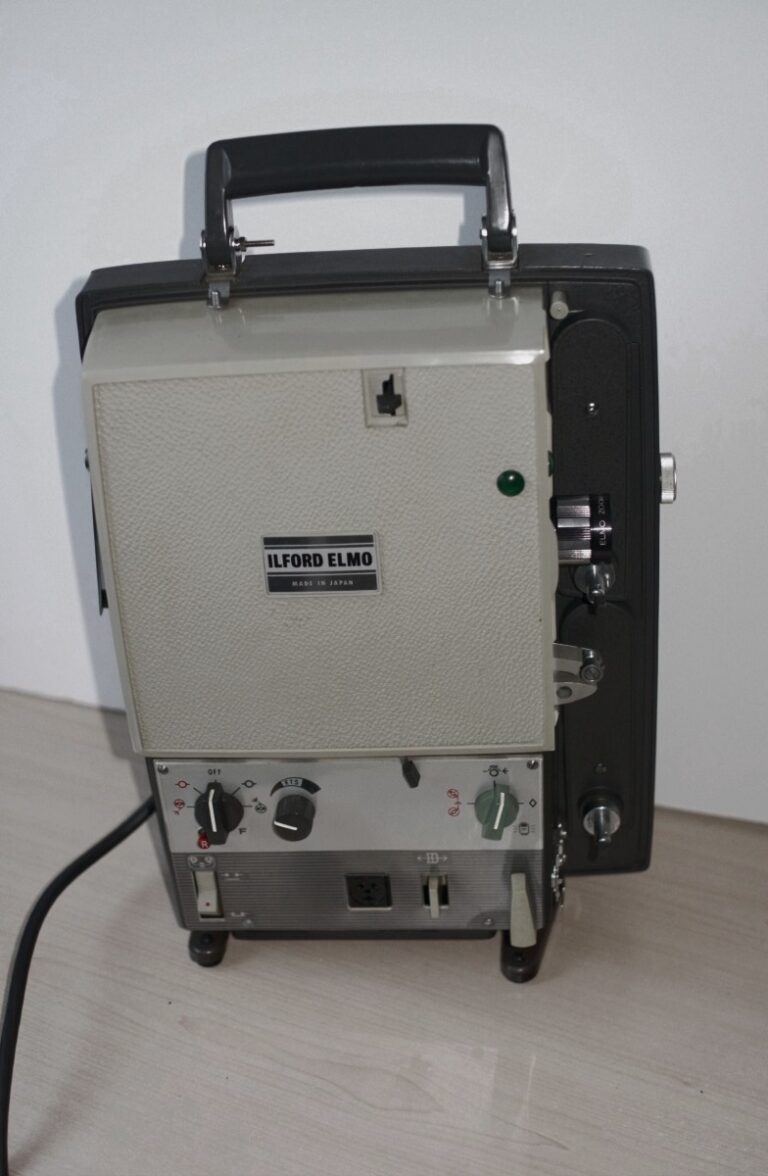The reliable and stylish Elmo FP-C dual standard projector from 1966.
The Elmo FP-C was one of a series of projectors made by Elmo in the mid to late 1960s and, in common with other Elmo projectors was notable for being well designed, well made and high quality. It is a dual standard design, capable of projecting both standard 8 and super 8 film, and has a novel, well engineered change over mechanism to select the film format.
Even though the FP-C is nearly 60 years old, it’s still a solid choice for anyone who wants to project their old family films in the 2020s.
My Elmo FP-C projector
I was actually gifted my copy of the Elmo FP-C by a reader called David who had a couple of projectors and some other cine equipment that belonged to his Father that he needed to dispose of and emailed me to see if I would be interested.
As it turns out I am very short on storage space at the moment and thought about saying I just couldn’t take them, but I’ve a soft spot for Elmo, and the two projectors David had (this Elmo FP-C and also an Elmo FP-A) had been on my wish list for sometime, so after a couple of emails to arrange the details I soon found myself with a couple of new additions to the collection.
When it tuned up I found that both projectors were in very good condition and had no mechanical problems that I could see, although the FP-C did have a missing lamp1.
Since the two projectors are so similar, I thought I could probably use the lamp from the FP-A in the FP-C, but it seems my copy is a very late one where the lamp was changed to a more modern, halogen design of type EJM. In with the paperwork was a note which said to ignore the advice in the handbook about replacing the lamp, and provided instructions for the new version, which has the name ‘Brilliant’ marked on the lamp housing cover.
As it happens, I didn’t have a type EJM lamp, and to purchase one would cost about £25, but I did find a similar lamp of type EKE on eBay which I purchased to use. I seems the type EKE is a shorter life version of the same bulb – it has a life of about 20 hours instead of the 50 hours of an EJM. However, I found a pack of 4 on eBay which I bought for £8, so the shorter life isn’t really a problem.
As I said, other than the lamp issue, the rest of the projector looked to be in very good mechanical condition with even the belts still driving the sprockets and mechanism well.
Unfortunately, although everything looked good, there were actually a couple of issues with the projector. First, the projection lens seemed to be really quite misty inside, with traces of fungus on the internal elements, so I would need to clean that up before the projector could really be used.
A more serious issue was that the auto-feed mechanism didn’t work at all and the projector chewed up films that were fed into it. After a bit of experimentation, I found that this seemed to be caused by the two plastic film guards around the sprockets being loose. Once I tightened the screws holding them in place the threading became more reliable.
The FP-C becomes the third Elmo projector in my collection joining an Elmo E-80 and an Elmo AP-8
Pictures of the Elmo FP-C dual format projector
- The Elmo FP-C with cover on
- The Elmo FP-C with cover off
- Lamp housing
- The halogen lamp fitted to the projector
- My model is a later version called ‘Brilliant’
- Back cover removed
- Mains input socket on back panel
- Film format indicator
- Dual reel holder on feed reel
- Take up spool stored in front cover
Description of the Elmo FP-C projector.
The Elmo FP-C is of upright design with the two film reels mounted at the top and the projection unit mounted underneath. A control panel with the operational controls sits at the bottom.
Format Change
As mentioned in the introduction the FP-C is a dual format projector. When it was introduced in 1966, Super 8 film had been available for about a year and there would be many people who had upgraded their cine equipment to the new, larger framed, super 8 film and needed a projector that could show both the new films they were taking, but also their old films which had been shot on standard 8 film.
Many manufacturers made projectors which would work with both formats, and many of these projectors had interchangeable sprocket wheels and adaptors to fit on the reel holders. Elmo thought about the problem and came up with a more novel approach.
On the FP-C the format change is done by selecting and activating the correct sprocket to use in the film transport area. Once the cover is swung out of the way, you can see the film transport sockets (shown here) with the super 8, red sprocket on top and the standard 8, grey sprocket on the bottom.
To switch formats, you move the two film guides away from the film path (these are the two plastic pieces with orange dots on) and then press in the required sprocket – red for super 8 or grey for standard 8.
When the sprockets are pushed firmly, the projector is set up for that format. A new frame surround is slid into place over the film gate, the sprockets move to their correct position so the film path is correct, and an indicator on the projector (just in front of where the film is fed into the projector) indicates either S or R for Super or Regular.
It’s a really rather novel approach and removes the problem of the bits which would be replaced when changing format getting lost.
Because Super 8 reels have a different size hole in the centre than standard 8, the feed reel holder on the FP-C had been designed to work with either size. The central spigot is fixed, but there is a surrounding expanded section which mates with a Super 8 reel, or is safely pushed into the projector if a Standard 8 reel is used.
Projecting a film
The steps to project a film with the FP-C are really quite simple.
First you set the projector up for the format of film that’s being shown. Once that’s done, the take up spool is mounted on the spigot at the rear of the projector, and the full reel is mounted on the front spigot.

To initiate the auto load, the green button on the top of the projection unit is pressed down and towards the front of the projector. It will click into place and then the film can be fed into the slot just above the lens. At this point the MOTOR control on the panel can be moved to the ‘Run’ position, and the LAMP control turned to the ‘On’ position and the film will be pulled into the projector.
Assuming everything goes well the film will appear at the rear of the projector and automatically connect with the take up spool and be collected.
Once the film is attached to the take up spool, the green auto load button at the top of the projector will snap back to it’s normal run position, and the Lamp automatically turns on and the film projection starts. Other than focusing the picture and setting the speed, the projectionist has nothing more to do and can join the rest of the audience and watch the film.
Once the film is complete, the MOTOR control can be turn to ‘Off’ and then the flim can be threaded from the take up spool straight onto the feed reel and the film rewound. This happens by again turning the MOTOR control to ‘Run’, but this time the button in the middle of the control is pressed down and the motor runs backwards.
It is possible to show the film backwards at any time before it finishes by stopping the projector and restarting with the button on the MOTOR control pressed down. There is also an effective heat shield which is placed in front of the lamp when the ‘Still’ option is selected, meaning the projector can show still images.
The projector gives a very bright and well defined image2.
Elmo FP-C handbook
A copy of the manual was included in the package David supplied, and I’ve scanned that and made it available on the site already, but I’ve also linked it here.
Elmo FP-C Specifications
- Elmo FP-C dual standard 8mm projector
- Introduced in 1966 although the unit featured in this article was probably made in 1969
- Novel Push button standard change over
- Indicator to show which format the projector is set to
- Bright 150W 21V lamp
- Forward and Reverse projection with speed control
- Automated loading and take-up
- Take up reel supplied and stored in front cover
- I was a while ago that I received the projectors, so it could be that there was a lamp but it was blown – if that’s the case sorry David! [↩]
- at least it would with a good, clean lens – my example is quite furry because it still needs to be cleaned [↩]
Discover more from Everything Vintage
Subscribe to get the latest posts sent to your email.















